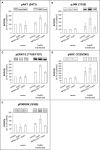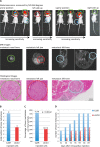Calcium-sensing receptor (CaSR) promotes development of bone metastasis in renal cell carcinoma
- PMID: 29644008
- PMCID: PMC5884663
- DOI: 10.18632/oncotarget.24607
Calcium-sensing receptor (CaSR) promotes development of bone metastasis in renal cell carcinoma
Abstract
Bone metastasis is an important prognostic factor in renal cell carcinoma (RCC). The calcium-sensing receptor (CaSR) has been associated with bone metastasis in several different malignancies. We analyzed the impact of CaSR in bone metastasis in RCC in vitro and in vivo. The RCC cell line 786-O was stably transfected with the CaSR gene and treated with calcium alone or in combination with the CaSR antagonist NPS2143. Afterwards migration, adhesion, proliferation and prominent signaling molecules were analyzed. Calcium treated CaSR-transfected 768-O cells showed an increased adhesion to endothelial cells and the extracellular matrix components fibronectin and collagen I, but not to collagen IV. The chemotactic cell migration and proliferation was also induced by calcium. The activity of SHC, AKT, ERK, P90RSK and JNK were enhanced after calcium treatment of CaSR-transfected cells. These effects were abolished by NPS2143. Development of bone metastasis was evaluated in vivo in a mouse model. Intracardiac injection of CaSR-transfected 768-O cells showed an increased rate of bone metastasis. The results indicate CaSR as an important component in the mechanism of bone metastasis in RCC. Therefore, targeting CaSR might be beneficial in patients with bone metastatic RCC with a high CaSR expression.
Keywords: bone metastases, metastasis; calcium-sensing receptor; kidney cancer; renal cell carcinoma.
Conflict of interest statement
CONFLICTS OF INTEREST No conflict of interest.
Figures







Similar articles
-
High calcium concentration in bones promotes bone metastasis in renal cell carcinomas expressing calcium-sensing receptor.Mol Cancer. 2014 Feb 28;13:42. doi: 10.1186/1476-4598-13-42. Mol Cancer. 2014. PMID: 24576174 Free PMC article.
-
[Bone metastasis by renal cell carcinoma. Importance of calcium and calcium-sensing receptor].Urologe A. 2015 Jun;54(6):839-43. doi: 10.1007/s00120-014-3716-9. Urologe A. 2015. PMID: 25503898 German.
-
Overexpression of a functional calcium-sensing receptor dramatically increases osteolytic potential of MDA-MB-231 cells in a mouse model of bone metastasis through epiregulin-mediated osteoprotegerin downregulation.Oncotarget. 2017 Apr 10;8(34):56460-56472. doi: 10.18632/oncotarget.16999. eCollection 2017 Aug 22. Oncotarget. 2017. PMID: 28915604 Free PMC article.
-
The Calcium-Sensing Receptor and Integrins in Cellular Differentiation and Migration.Front Physiol. 2016 May 26;7:190. doi: 10.3389/fphys.2016.00190. eCollection 2016. Front Physiol. 2016. PMID: 27303307 Free PMC article. Review.
-
The calcium-sensing receptor in bone metabolism: from bench to bedside and back.Osteoporos Int. 2015 Aug;26(8):2055-71. doi: 10.1007/s00198-015-3203-1. Epub 2015 Jun 23. Osteoporos Int. 2015. PMID: 26100412 Review.
Cited by
-
Identifying Prognostic Biomarkers Related to m6A Modification and Immune Infiltration in Renal Cell Carcinoma.Genes (Basel). 2022 Nov 7;13(11):2059. doi: 10.3390/genes13112059. Genes (Basel). 2022. PMID: 36360294 Free PMC article.
-
Metabolite Sensing GPCRs: Promising Therapeutic Targets for Cancer Treatment?Cells. 2020 Oct 23;9(11):2345. doi: 10.3390/cells9112345. Cells. 2020. PMID: 33113952 Free PMC article. Review.
-
Modeling Neoplastic Growth in Renal Cell Carcinoma and Polycystic Kidney Disease.Int J Mol Sci. 2021 Apr 10;22(8):3918. doi: 10.3390/ijms22083918. Int J Mol Sci. 2021. PMID: 33920158 Free PMC article. Review.
-
Bone Tropism in Cancer Metastases.Cold Spring Harb Perspect Med. 2020 Oct 1;10(10):a036848. doi: 10.1101/cshperspect.a036848. Cold Spring Harb Perspect Med. 2020. PMID: 31615871 Free PMC article. Review.
-
New players in the landscape of renal cell carcinoma bone metastasis and therapeutic opportunities.Int J Cancer. 2025 Feb 1;156(3):475-487. doi: 10.1002/ijc.35181. Epub 2024 Sep 22. Int J Cancer. 2025. PMID: 39306698 Free PMC article. Review.
References
-
- Society AC . Cancer Facts & Figures 2016. Atlanta: American Cancer Society; 2016.
-
- Chow WH, Devesa SS, Warren JL, Fraumeni JF., Jr Rising incidence of renal cell cancer in the United States. JAMA. 1999;281:1628–31. - PubMed
-
- Decastro GJ, McKiernan JM. Epidemiology, clinical staging, and presentation of renal cell carcinoma. Urol Clin North Am. 2008;35:581–92. https://doi.org/10.1016/j.ucl.2008.07.005. - DOI - PubMed
-
- Sun M, Choueiri TK. Kidney cancer: Recurrence in renal cell carcinoma: the work is not done. Nat Rev Urol. 2016;13:246–7. https://doi.org/10.1038/nrurol.2016.57. - DOI - PubMed
-
- Mikami S, Oya M, Mizuno R, Kosaka T, Katsube KI, Okada Y. Invasion and metastasis of renal cell carcinoma. Medical molecular morphology. 2014;47:63–7. - PubMed
LinkOut - more resources
Full Text Sources
Other Literature Sources
Research Materials
Miscellaneous

